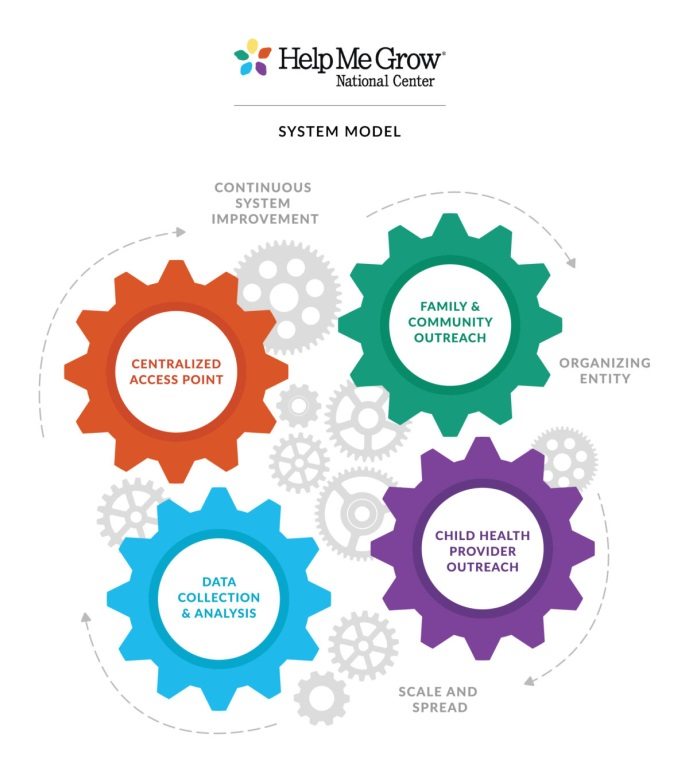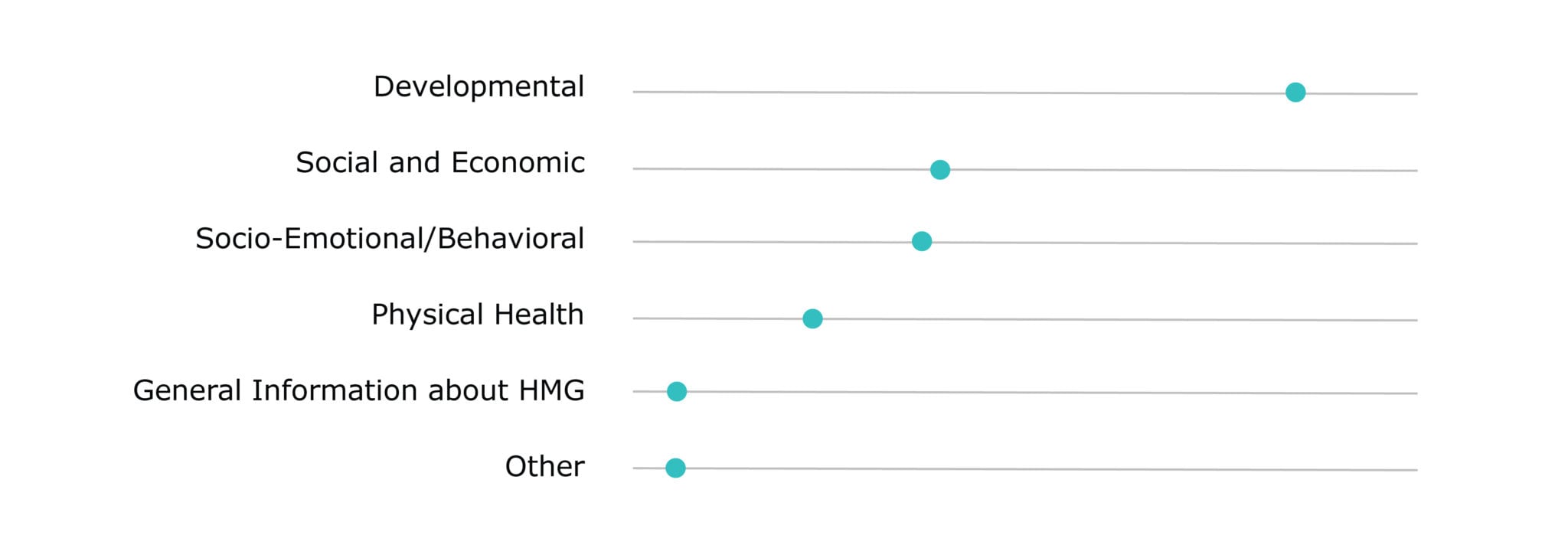

California has invested a significant amount of money and time to build an impressive early care and education system to serve over 500,000 children under age 5. Understandably, it is challenging to align efforts across this large and complex system because it involves reorienting existing practices that reflect deeply held values and norms. Our colleagues Rami Arafah and Raúl Martínez have worked with an approach that is building steam to align these efforts in counties across the state – Help Me Grow.
In this interview we asked them to fill us in on how this model is spreading to reach more children and families in California.
What is Help Me Grow trying to achieve?
Rami: Help Me Grow is a systems model with the goal of promoting and fostering healthy children and families. The primary path towards that goal is through early identification of developmental, learning, and behavioral issues and delays with children. The idea is: identify early, refer families to services, and then provide care coordination. The model is built around leveraging and utilizing existing infrastructures, systems, and networks within local communities.
Raúl: Help Me Grow relies on various stakeholders to meet the needs of children and families. Some of those needs can be met right away, and some of them require more thought, attention, referral, and care coordination, like you said, Rami.
Part of the problem that Help Me Grow addresses is that many kids, particularly in California, are not being screened for developmental delays. Just 29% of children in California receive timely screenings according to Children Now, so Help Me Grow is one way to address that gap.
How is Help Me Grow working to align efforts in early care?
Rami: There are four core components to the Help Me Grow model:
- You have to have a centralized access point, where parents, providers, pediatricians—whoever has a concern or a question—can access Help Me Grow. That’s typically a call center with trained staff who are able to answer questions on the spot if that’s enough to handle the issue, or make referrals where necessary.
- Number two is family and community outreach. That’s to parents, and it’s also to community-based organizations serving families.
- The third core component is child health care provider outreach. That would most typically be pediatricians or people conducting well child visits, to train them on using validated screening tools, and the merits of using them.
- The fourth one, which is where Harder+Company comes in, is data collection and analysis towards continuous improvement.

Image from the Help Me Grow National Center
Raúl: One of the core partners for Help Me Grow is health care providers, since they have unique access to children and families, particularly during the first three years of a child’s life. According to the Centers for Disease Control, less than 50% of pediatricians across the country use valid and reliable screening tools. Help Me Grow establishes partnerships with healthcare providers, including pediatricians, to work with them to use research-based tools that can detect concerns or delays, so that kids get what they need.
Providing a centralized access line to parents is also unique because the person that’s on the other end of the line is trained and is familiar with child development. Other call lines may not have that level of training and orientation to the issues facing young kids and families.
How is Help Me Grow in California different from other places in the country?
Rami: Help Me Grow came to California fairly early on. It started with a pilot in Connecticut in 2002. From there, the first replication site was Orange County in 2005.
Help Me Grow is centrally managed and coordinated at the state level in most places across the country. In California, as with most things in California, it’s county-based, which is a pragmatic approach that allows for more specialized visions at the local level.
Affiliate Counties

Raúl: The model is flexible enough that it can be adapted to meet local needs, similar to how First 5 programs are implemented across the state.
The other piece that’s different in California is the attention that’s been paid to data. Affiliates in California have been in close contact with the Help Me Grow National Center about improving upon the initial set of questions, indicators, and items included in the Help Me Grow reporting form. In California, that’s meant adding in variables that are of interest to state-level stakeholders. It’s also meant streamlining and, in some cases, eliminating certain indicators. California’s Help Me Grow affiliates came together to create an evaluation framework that focuses on statewide audiences. Documenting impact has been a way to build support for Help Me Grow expansion across the state.
How is Harder+Company supporting the Help Me Grow approach?
Rami: We work with the First 5 Association of California to convene Help Me Grow affiliates, make sure that they are using universal and standardized reporting tools, aggregate the data, and then report in a way that’s going to be useful and helpful, both to the affiliates themselves and also tell a larger story at the state level. It’s a testament to their willingness to be a part of this in that they see the value for their own local implementation, but also for the sustainability of Help Me Grow California.
What are we learning from the data?
Rami: The data for this past year shows how Help Me Grow has increased reach to children and families, improved outcome attainment, and general improvements in data cleanliness, completeness, and consistency.
Help Me Grow reached 20% more children this year compared to 2015

In 2016, our data shows that Help Me Grow reached over 16,000 children across the state, which is up 20% from the previous year. We found that the most common concern was about developmental issues, and 70% of those referrals led to positive outcomes for families.
Developmental concerns were the most common presenting issue

Raúl: Ultimately, the goal of Help Me Grow is to connect families to the support they need to address these issues. From 2015 to 2016, 31% more kids were connected to services.
2016 saw a 31% increase in the number of children connected to or pending connection to services

Rami: We also track referrals going out of the call center. One of the things we mentioned earlier was that developmental concerns are the most common issue coming in. It’s interesting to see that referrals for social and economic support are the most common output as a result. I think it’s a testament to the success of Help Me Grow as a really holistic hub, where people are coming in with very targeted concerns and then coming out, most likely, with a referral for the concern that brought them there as well as connections to other services that are going to help strengthen the family and increase protective factors.
The most common referral type was for social and economic support services

This progress is really great to see. Of course, we know that there is a lot of work that goes into aligning these systems. Have there been challenges along the way?
Rami: Reaching out to medical providers—building a sense of trust and credibility and getting them on board with the model—has been a pretty universal challenge. Earlier this year we conducted a nationwide scan of Help Me Grow systems to inform the plan for Help Me Grow implementation in Fresno County. In our interviews with several California affiliates for that scan, across the board, one of the biggest challenges that we heard about was child health care provider outreach.
What’s ahead for Help Me Grow in California?
Rami: There’s a lot of energy and momentum right now behind Help Me Grow expansion in California. At the time that we closed reporting for calendar year 2016 there were 14 counties on board. In the time since, three counties have jumped on. There are 15 additional counties that are now in a pre-affiliate planning stage, who want to make their way into Help Me Grow. So, we could see potentially over 30 affiliate counties join in 2018, which I think is why the data reporting infrastructure that we’ve have helped set up is so crucial for moving forward. It needs to be a well-oiled machine for those 30-plus counties.
Raúl: Not only are more affiliates coming online, but stakeholders that were once disinterested in supporting early childhood development are becoming interested in this systems change effort—including county boards of supervisors. It’s not just statewide players but also decision makers at a local level that are in positions to influence and build political and public support for Help Me Grow.
